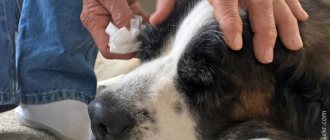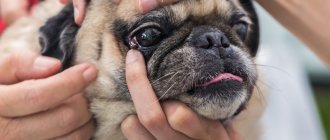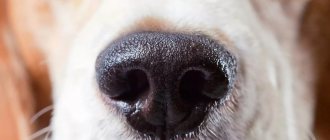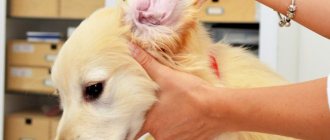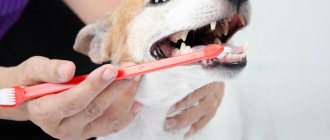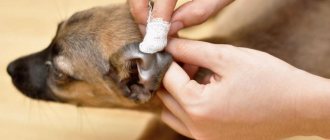Not all owners know how to wipe their dog’s eyes and how often they need to be cleaned. The algorithm and frequency of washing depend on the purpose pursued and the health of the animal. In some cases, ordinary water is not enough - special preparations from a human first aid kit or a pet store can cope with serious contaminants and pathologies.
Basics of dog eye hygiene
Regular eye care for your dog is necessary to prevent ophthalmic diseases. The treatment itself is carried out using cotton pads and a cleanser according to the following algorithm:
- Carefully fix the head and body of the animal. Small dogs are wrapped in a blanket, and large dogs are held with a leash. When working with cowardly and aggressive pets, you may need an assistant—and a muzzle.
- The disc is moistened in the solution and wiped over one eye, moving from the outer corner to the inner one. Please note that a separate cotton pad is required for each eye. Ordinary cotton wool is not suitable for cleansing, as its villi can damage the mucous membranes.
- If necessary, remove dried crusts. This requires a little more liquid and time. A well-moistened disc is applied to the problem area until it softens.
Heavy dirt near the eyelids, and not on the eye itself, is best removed under pressure. A sterile syringe without a needle is suitable for this.
Symptoms
Clinical signs of ocular inflammation are difficult to miss:
- Constant squinting.
- Redness of the conjunctiva.
- Swelling.
- Excessive tearing.
- Mucous or purulent discharge.
- Clouding of the cornea and lens.
- Redness, crusts, scales along the edges of the eyelids.
- Sticking or loss of eyelashes.
- Itching.
If at least one alarming symptom appears, the dog should be shown to a veterinarian in order to carry out a differentiated diagnosis and prescribe the correct treatment.
When is rinsing required?
Washing is performed not only for preventive purposes, but also for therapeutic purposes. In the first case, the frequency of the procedure depends on the characteristics of the pet, and in the second, on the recommendations of the veterinarian.
Daily procedure
The appearance of colorless or pale gray discharge in the corners of the eyes after sleep is absolutely normal. Accumulating liquid indicates the correct functioning of the lacrimal apparatus. It is removed as needed, but at least once a week. More frequent cleaning is necessary for the following breeds:
- Pekingese, pugs and chihuahuas with bulging eyes;
- lap dogs, Yorkies and Shih Tzus with too long hair on the face;
- spaniels, sharpeis and basset dogs with drooping eyelids;
- boxers, bulldogs, Japanese chins and other brachycephalic dogs with a shortened and flattened muzzle.
Older dogs are also at risk. With age, the production of tear fluid deteriorates, so a pronounced dullness appears on the cornea. Lack of regular hydration and rare cleansing are fraught with the development of chronic conjunctivitis and even blindness.
In case of illness
When the visual organ is damaged, the body activates a protective function. This is accompanied by an increase in the amount of tear fluid and the onset of the inflammatory process.
The presence of pathogenic microflora can be recognized by the consistency and color of the discharge. The liquid that accumulates in the corners becomes cloudy and turns yellowish-green or brown. When dry, it sticks together the eyelids and eyelashes, preventing the eyes from opening easily.
Depending on the cause of the disease, the veterinarian prescribes antibiotics, anti-inflammatory and other drugs. To increase their effectiveness, pre-rinsing is necessary. Otherwise, the medicine will not be able to distribute over the entire surface of the eye.
What is meningoencephalitis?
Meningoencephalitis is an inflammatory process in the brain of dogs. This disease often passes so quickly that the animal simply dies before our eyes. With meningoencephalitis, the brain itself and the cerebral cortex are affected.
Bacterial meningoencephalitis can be caused by plague and viral infections, and non-bacterial meningoencephalitis can be caused by helminthic infestation and traumatic brain injury.
The prognosis of this disease is disappointing - the mortality rate is very high due to lack of response to drugs.
Treatment depends on what type of meningoencephalitis. Usually prescribed injections of cytarabine, antibiotics ampicillin, enrofloxacin. Therapy is continued for 2 weeks. In addition, vitamins and anticonvulsants are prescribed.
How can you wash your dog's eyes?
Antiseptics and folk remedies are used for preventive purposes as needed. All other medications are selected by the doctor, since in case of illness, self-medication is fraught with worsening.
Products from a pet store
Pet store products do not require dilution. The active substance they contain corresponds to the physiology of tetrapods. The owner must comply with the dosage, which differs for animals of different ages and weight categories.
If you don’t know how to wash your puppy’s eyes, buy Diamond Eyes eye drops. This drug has no side effects, so veterinarians recommend using it for prevention. It acts as an antiseptic and fights mild inflammation and swelling.
Antibiotics, steroidal anti-inflammatory and antihistamines should be taken with caution. Here you should trust your veterinarian.
The method of use of the drug depends on the form of its release:
- Drops. Apply directly to mucous membranes. After this, the eyelids are closed, simulating blinking for better distribution.
- Ointments. Place it in the corner of the eye, slightly pulling the lower eyelid.
- Gels. Unlike ointment, the gel does not contain fat and is quickly absorbed. It is used to treat wounds.
- Lotions. They soak a cotton pad. They are suitable for daily cleansing and prevent the formation of tear tracks.
Another convenient form of release is wet wipes. They can clean not only the eyes, but also the paws, as well as any other part of the body. Most often they are used on the road when traveling.
Remedies from the human pharmacy
Many owners are interested in whether it is possible to wash their dog’s eyes with chlorhexidine, since this antiseptic is available in almost every home. Veterinarians give a positive answer to this question, but remind them of the need to reduce the dosage specified in the instructions.
Recommendations for the use of drugs from a human first aid kit are as follows:
- Chlorhexidine. For four-legged pets, a 0.05% solution is recommended. Before use, it is diluted with water or saline in a ratio of 1:5.
- Furacilin. Another antiseptic that requires preliminary dilution (100 ml of water per 20 mg of the drug). Both forms of release are suitable for washing: tablets and solution.
- Miramistin. The only human medicine that can be used at its original concentration. Due to its low effectiveness, miramistin is usually used as part of complex therapy.
- Saline solution. It is prepared from 0.5 tsp. salt and 1 tbsp. warm water. Suitable for treating diseases in the early stages.
- Sodium chloride. Saline solution at a dosage of 0.9% is completely safe for the body and does not require additional manipulations. To process, simply apply it to a cotton pad.
- Potassium permanganate. A strong and effective antiseptic with one big drawback - a high probability of getting a burn to the mucous membrane. When preparing the solution, it is important to dissolve all the crystals and do not forget about filtration. For 250 ml of water, only 1 crystal will be enough.
- Boric acid. Another crystalline substance that requires special attention when using it. A solution for dogs is prepared by dissolving ¼ tsp. powder in 200 ml of warm water. Uncontrolled use is fraught with poisoning, so do not resort to boric acid without a prescription from a veterinarian.
The most harmless drugs include saline solution (sodium chloride), chlorhexidine, furatsilin, miramistin and saline solution. All other medications are best taken under the supervision of your doctor.
Folk remedies
Folk remedies prepared at home are also suitable for daily procedures. The most popular of them include the following:
- Chamomile infusion. Relieves inflammation, heals wounds and effectively removes impurities. To prepare, you need to brew 1 tbsp. l. dried chamomile in 200 ml of boiling water and leave to infuse for 15-20 minutes. Before processing, the broth is cooled to room temperature.
- Aloe juice. It has an antibacterial effect, removes toxins, relieves pain, normalizes metabolism and strengthens the immune system. Before use, the thick juice is diluted with warm water and filtered through cheesecloth.
- Tea brewing. Has a tonic and anti-inflammatory effect. To cleanse the eyes, a weak brew based on black or green tea without additives, left for at least 2 hours after brewing, is suitable. In addition to cotton pads, tea bags themselves are also used.
Please note that all folk remedies are used on the day of preparation. Otherwise, they will turn sour and acquire an unpleasant odor.
The disadvantages of these recipes include their low effectiveness and high likelihood of allergies. Before treatment, it is recommended to test the body's reaction on a small area of skin. Depending on the consequences, it will become clear what can be used to wash your dog’s eyes and what is better to avoid.
Necrotizing encephalitis
Necrotizing encephalitis has been poorly studied and is practically untreatable.
Most common symptoms:
- decreased appetite;
- weight loss;
- limping;
- lack of coordination;
- sudden change in behavior;
- pain;
- convulsions.
Timely detection of symptoms of the disease and contacting a clinic can, despite the poor prognosis for this disease, lead to positive results.
As a result of the examination, the veterinarian will prescribe surgical or other treatment.
When to contact a veterinarian
Advanced ophthalmological diseases can lead to blindness, so it is very important not to delay diagnosis if alarming signs occur. These include:
- pain on palpation of the eyeballs;
- swelling of the eyelids;
- squinting in bright light;
- scratching the muzzle and eyelids with paws, accompanied by plaintive whining;
- redness of mucous membranes;
- increased tearfulness, change in color and consistency of discharge;
- increase in temperature;
- prolonged apathy, deterioration or lack of appetite.
These symptoms are characteristic of allergies, viral infections, hormonal disorders and other pathologies. The exact cause of the malaise is determined only on the basis of tests. Depending on the results, the veterinarian will tell you how to wash the dog’s eye from pus and how to eliminate the root cause of the disease.
CORNEAL DYSTROPHY
The cornea is the outer layer of the eye. Clouding of this layer is corneal dystrophy. Most often, this disease is hereditary, affecting both eyes.
Symptoms include the appearance of a spot on the eyeball that gradually increases in size.
Unfortunately, the disease has no cure. There is no treatment. At the same time, the animal’s vision is preserved, although it is partially blocked.
Prevention
There is no one hundred percent guarantee that a pet will never be injured, but loving owners are responsible for it and must make efforts to minimize such risks.
It is important to choose the right places for walking with your animal, to avoid abandoned construction sites and overgrown paths in park areas.
Hunters need to choose the right breed of dog, since much depends on what animal is being hunted and what is required from the dog.
During play, you should follow safety precautions when working with an animal and not expose it to unnecessary risk of injury.
It is also worth excluding contacts with unfamiliar and especially stray dogs as much as possible. It is necessary to limit possible meetings with felines (unless this is a dog’s best friend). Otherwise, your pet may suffer from sharp claws.
Do not try to play the role of a doctor and treat an animal.
Medicines are sold in pharmacies in the form of lotions, drops and ready-made solutions. You can also purchase sanitary napkins for your eyelids. The drugs have different prices and purposes. The listed remedies should be used with caution.
If rinsing does not help, the dog must be taken to the veterinarian. Before purchasing a medicine, you need to carefully study its composition. You should not take solutions that contain antibiotics, hydrogen peroxide, ethyl alcohol and other aggressive chemical components.
Temperature change
Fever is a warning sign that both people and dogs are feeling unwell. The normal temperature for Yorkies is 38.5-39 degrees.
NOTE!
On hot days and during heat, a Yorkie's temperature can rise by 3 degrees, and before giving birth it can drop by 0.5-2 degrees.
The cause of high temperature can be tick-borne piroplasmosis, viral enteritis, poisoning and postpartum eclampsia.
If your pet has a fever and chills, wet the ears and paw pads with cool water, place the pet in a cool room, and give him fresh water. You need to inject about 50 ml of saline solution into the withers using a syringe or mix Nosh-pu, analgin and diphenhydramine in a syringe and inject it intramuscularly.
If the temperature drops below normal, warm your dog by wrapping him in a warm blanket with heating pads or a hot water bottle.
Providing first aid to a pet
Before contacting a veterinarian, the owner can help the pet to alleviate its condition:
- The eyes are washed with a cotton pad moistened with a weak solution of potassium permanganate, furacillin or chamomile decoction.
- Purulent crusts are removed with a tampon with Vaseline oil.
- The drugs Maxidin, Iris or ConjunctiveVET are instilled into the eyes.
- For obvious purulent discharge, Tsiprovet, Bars, Anandin are dripped. For gas conjunctivitis, dogs are washed with a chamomile decoction, a solution of manganese or furatsilin.
If it is not possible to visit a doctor, treatment according to this regimen should be carried out for 4-7 days. Procedures are carried out three times a day. Improvement should occur after 2-3 days of such treatment. If treatment does not help, you should definitely visit a canine ophthalmologist.
Recommended vaccinations
Professional dog breeders advise using drugs from foreign manufacturers to vaccinate Yorkies:
- NobivakLepto;
- NobivakDHPPI;
- Hexadog;
- Eurican.
It is necessary to re-vaccinate as it expires after a year. These drugs have gained popularity due to the fact that pets tolerate them well.
What not to do if you have watery eyes
Having discovered severe tearing, every owner wants to help their pet. But you have to be careful not to harm him.
If there is a strong secretion of tear fluid, it is not recommended:
- Touch the sore spot with dirty hands. You can get an infection.
- Apply tea and alcohol-based solution onto the cornea. The drugs irritate it, causing inflammation.
- Use cotton wool. The fibers stick to the mucous membrane and cause discomfort. Smooth cotton pads are suitable for the procedures.
- Apply cosmetics in the form of sprays and aerosols around the dog. Tobacco smoke also irritates the peephole.
- Try to identify the disease and treat the animal yourself. You need to contact your veterinarian for help.
Consultation with a veterinarian to identify the disease
By following these rules, the owner will not harm the health of his dog.
